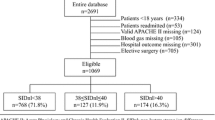Abstract
Objective: To determine the relationship between ionized calcium concentrations and blood lactate levels during cardiac arrest and cardiopulmonary resuscitation (CPR).
Design: A prospective cohort study.
Setting: Emergency department (ED) and general intensive care unit in a city hospital (tertiary care center).
Patients and participants: 32 patients with out-of-hospital cardiac arrest; 14 of the patients had a return of spontaneous circulation (ROSC) and 18 of the patients died.
Interventions: Basic and advanced life support.
Measurements and results: Concentrations of ionized and total calcium, bicarbonate, lactate, and pyruvate and pH were simultaneously determined immediately upon arrival at the ED, and at 30 and 60 min. Upon arrival at the ED, all patients had ionized hypocalcemia (1.09 ± 0.02 mmol/1). Ionized and total calcium concentrations progressively decreased during and after CPR, but pH and bicarbonate concentrations did not show any significant changes. In patients who had ROSC, a significant, but perhaps not clinically relevant, relationship was observed between the ionized calcium concentrations and pH (r2=0.152, p=0.0117). In the patients who died, there were significant correlations between ionized calcium and pH (r2=0.382, p= 0.0001) and bicarbonate concentrations (r2=0.298, p=0.0006). No definite correlations were demonstrated when comparing ionized calcium concentrations with lactate and pyruvate concentrations.
Conclusions: Ionized hypocalcemia during out-of-hospital cardiac arrest and CPR is not due to binding by both lactate and pyruvate, but may be partly due to complexing by bicarbonate, with some modifications due to variations in pH.
Similar content being viewed by others
References
Zaloga GP, Chernow B (1986) Hypocalcemia in critical illness. JAMA 256: 1924–1929
Zaloga GP (1992) Hypocalcemia in critically ill patients. Crit Care Med 20: 251–262
Gando S, Tedo I, Tujinaga H, Kubota M (1988) Variation in serum ionized calcium on cardiopulmonary resuscitation. J Anesth 2: 154–160
Gando S, Tedo I, Kubota M (1990) A comparison of serum ionized calcium in arterial and mixed venous blood during CPR. Ann Emerg Med 19: 850–856
Urban P, Scheidegger D, Buchmann B, Barth D (1988) Cardiac arrest and blood ionized calcium levels. Ann Intern Med 109:110–113
Cairns CB, Niemann JT, Pelikan PCD, Sharma J (1991) Ionized hypocalcemia during prolonged cardiac arrest and closed-chest CPR in a canine model. Ann Emerg Med 20: 1178–1182
American Heart Association (1992) Guidelines for cardiopulmonary resuscitation and emergency cardiac care. JAMA 268: 2171–2295
Cummins RO, Chamberlain DA, Abramson NS, Allen M, Baskett P, Becker L, Bossaert L, Delooz H, Dick W, Eisenberg M, Evans T, Holmberg S, Kerber R, Mullie A, Ornato JP, Sandoe E, Skulberg A, Tunstall-Pedoe H, Swanson R, Theis WH (1991) Recommended guidelines for uniform reporting of data from out-of-hospital cardiac arrest: the Utstein style. Ann Emerg Med 20: 861–874
Salerno DM, Elsperger KJ, Helseth P, Murakami M, Chepuri V (1987) Serum potassium, calcium and magnesium after resuscitation from ventricular fibrillation: a canine study. J Am Coll Cardiol 10: 178–185
Koch SM, Mehlhorn U, McKinley BA, Irby SL, Warters RD, Allen SJ (1995) Arterial blood sampling devices influence ionized calcium measurements. Crit Care Med 23: 1825–1828
Nawab ZM, Daugirdas JT, Ing TS, Leehey DJ, Reid RW, Klock MA (1984) Calcium-complexing versus vasorelaxant effect of acetate, lactate, and other bases. Trans Am Soc Artif Intern Organs 30: 184–188
Cheung JY, Bonventre JV, Malis CD, Leaf A (1986) Calcium and ischemic injury. N Engl J Med 314: 1670–1676
Nakanishi T, Seguchi M, Tsuchiya T, Yasukouchi S, Takao A (1990) Effect of acidosis on intracellular pH and calcium concentration in the newborn and adult rabbit myocardium. Circ Res 67: 111–123
Kristiän T, Katsura K, Gidö G, Siesjö BK (1994) The influence of pH on cellular calcium influx during ischemia. Brain Res 641: 295–302
Prengel AW, Linder KH, Ensinger H, Grünert A (1992) Plasma catecholamine concentrations after successful resuscitation in patients. Crit Care Med 20: 609–614
Author information
Authors and Affiliations
Additional information
No financial support or grant was provided for this study
Rights and permissions
About this article
Cite this article
Gando, S., Igarashi, M., Kameue, T. et al. Ionized hypocalcemia during out-of-hospital cardiac arrest and cardiopulmonary resuscitation is not due to binding by lactate. Intensive Care Med 23, 1245–1250 (1997). https://doi.org/10.1007/s001340050493
Received:
Accepted:
Issue Date:
DOI: https://doi.org/10.1007/s001340050493




